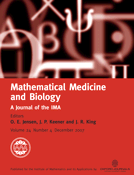-
Views
-
Cite
Cite
A. Heryudono, R. J. Braun, T. A. Driscoll, K. L. Maki, L. P. Cook, P. E. King-Smith, Single-equation models for the tear film in a blink cycle: realistic lid motion, Mathematical Medicine and Biology: A Journal of the IMA, Volume 24, Issue 4, December 2007, Pages 347–377, https://doi.org/10.1093/imammb/dqm004
Close - Share Icon Share
Abstract
We consider model problems for the tear film over multiple blink cycles that utilize a single equation for the tear film; the single non-linear partial differential equation that governs the film thickness arises from lubrication theory. The two models that we consider arise from considering the absence of naturally occurring surfactant and the case when the surfactant is strongly affecting the surface tension. The film is considered on a time-varying domain length with specified film thickness and volume flux at each end; only one end of the domain is moving, which is analogous to the upper eyelid moving with each blink. Realistic lid motion from observed blinks is included in the model with end fluxes specified to more closely match the blink cycle than those previously reported. Numerical computations show quantitative agreement with in vivo tear film thickness measurements under partial blink conditions. A transition between periodic and non-periodic solutions has been estimated as a function of closure fraction and this may be a criterion for what is effectively a full blink according to fluid dynamics.





